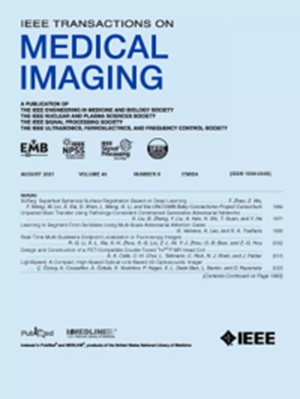Stroke-Aware CycleGAN: Improving Low-Field MRI Image Quality for Accurate Stroke Assessment.
IF 9.8
1区 医学
Q1 COMPUTER SCIENCE, INTERDISCIPLINARY APPLICATIONS
引用次数: 0
Abstract
Low-field portable magnetic resonance imaging (pMRI) devices address a crucial requirement in the realm of healthcare by offering the capability for on-demand and timely access to MRI, especially in the context of routine stroke emergency. Nevertheless, images acquired by these devices often exhibit poor clarity and low resolution, resulting in their reduced potential to support precise diagnostic evaluations and lesion quantification. In this paper, we propose a 3D deep learning based model, named Stroke-Aware CycleGAN (SA-CycleGAN), to enhance the quality of low-field images for further improving diagnosis of routine stroke. Firstly, based on traditional CycleGAN, SA-CycleGAN incorporates a prior of stroke lesions by applying a novel spatial feature transform mechanism. Secondly, gradient difference losses are combined to deal with the problem that the synthesized images tend to be overly smooth. We present a dataset comprising 101 paired high-field and low-field diffusion-weighted imaging (DWI), which were acquired through dual scans of the same patient in close temporal proximity. Our experiments demonstrate that SA-CycleGAN is capable of generating images with higher quality and greater clarity compared to the original low-field DWI. Additionally, in terms of quantifying stroke lesions, SA-CycleGAN outperforms existing methods. The lesion volume exhibits a strong correlation between the generated images and the high-field images, with R=0.852. In contrast, the lesion volume correlation between the low-field images and the high-field images is notably lower, with R=0.462. Furthermore, the mean absolute difference in lesion volumes between the generated images and high-field images (1.73±2.03 mL) was significantly smaller than the difference between the low-field images and high-field images (2.53±4.24 mL). It shows that the synthesized images not only exhibit superior visual clarity compared to the low-field acquired images, but also possess a high degree of consistency with high-field images. In routine clinical practice, the proposed SA-CycleGAN offers an accessible and cost-effective means of rapidly obtaining higher-quality images, holding the potential to enhance the efficiency and accuracy of stroke diagnosis in routine clinical settings. The code and trained models will be released on GitHub: SA-CycleGAN.卒中感知CycleGAN:提高低场MRI图像质量,准确评估卒中。
低场便携式磁共振成像(pMRI)设备通过提供按需和及时访问MRI的能力,特别是在常规卒中紧急情况下,解决了医疗保健领域的一个关键需求。然而,这些设备获得的图像通常清晰度差,分辨率低,导致其支持精确诊断评估和病变量化的潜力降低。在本文中,我们提出了一个基于3D深度学习的模型,命名为卒中感知CycleGAN (SA-CycleGAN),以提高低场图像的质量,进一步提高常规卒中的诊断。首先,在传统CycleGAN的基础上,SA-CycleGAN采用一种新的空间特征变换机制,结合脑卒中病变先验;其次,结合梯度差损失,解决了合成图像过于光滑的问题;我们提出了一个由101对高场和低场扩散加权成像(DWI)组成的数据集,这些数据是通过对同一患者近距离的双重扫描获得的。我们的实验表明,与原始的低场DWI相比,SA-CycleGAN能够生成质量更高、清晰度更高的图像。此外,在量化脑卒中病变方面,SA-CycleGAN优于现有方法。病变体积与高场图像具有较强的相关性,R=0.852。相比之下,低场图像与高场图像的病灶体积相关性明显较低,R=0.462。生成图像与高场图像病变体积的平均绝对差值(1.73±2.03 mL)明显小于低场图像与高场图像病变体积差值(2.53±4.24 mL)。实验结果表明,合成图像不仅比低场图像具有更好的视觉清晰度,而且与高场图像具有高度的一致性。在常规临床实践中,所提出的SA-CycleGAN提供了一种易于获取且成本效益高的方法,可以快速获得高质量的图像,有可能提高常规临床环境中中风诊断的效率和准确性。代码和训练模型将在GitHub: SA-CycleGAN上发布。
本文章由计算机程序翻译,如有差异,请以英文原文为准。
求助全文
约1分钟内获得全文
求助全文
来源期刊

IEEE Transactions on Medical Imaging
医学-成像科学与照相技术
CiteScore
21.80
自引率
5.70%
发文量
637
审稿时长
5.6 months
期刊介绍:
The IEEE Transactions on Medical Imaging (T-MI) is a journal that welcomes the submission of manuscripts focusing on various aspects of medical imaging. The journal encourages the exploration of body structure, morphology, and function through different imaging techniques, including ultrasound, X-rays, magnetic resonance, radionuclides, microwaves, and optical methods. It also promotes contributions related to cell and molecular imaging, as well as all forms of microscopy.
T-MI publishes original research papers that cover a wide range of topics, including but not limited to novel acquisition techniques, medical image processing and analysis, visualization and performance, pattern recognition, machine learning, and other related methods. The journal particularly encourages highly technical studies that offer new perspectives. By emphasizing the unification of medicine, biology, and imaging, T-MI seeks to bridge the gap between instrumentation, hardware, software, mathematics, physics, biology, and medicine by introducing new analysis methods.
While the journal welcomes strong application papers that describe novel methods, it directs papers that focus solely on important applications using medically adopted or well-established methods without significant innovation in methodology to other journals. T-MI is indexed in Pubmed® and Medline®, which are products of the United States National Library of Medicine.
 求助内容:
求助内容: 应助结果提醒方式:
应助结果提醒方式:


